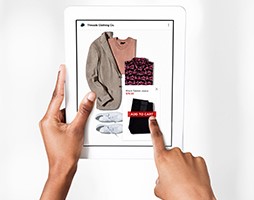Shoppable ads shorten consumers’ paths to purchase
September 6, 2019New digital ad format allows users to browse products and ‘add-to-cart’
BY SEAN C. TARRY

Technology has impacted the way we do, well, just about everything. So, it’s hardly surprising that it’s also changed the way we shop. Whether we’re comparing specs, reading reviews, or making that final purchase, online shopping is becoming the new norm. eMarketer estimates that Canadians will spend nearly $65 billion online in 2019, which is up more than 20 percent from 2018.
But the shift to anytime, anywhere access and unlimited product offerings has heightened consumer expectations. More than ever, retailers need to provide consumers with highly personalized offers and a convenient checkout process—and that’s where Contobox comes in. The interactive ad platform recently developed shoppable ads for the open web to help brands gain unique insights into consumer behaviour and shorten their paths to purchase.
We spoke with Andrew Bester, Director of Enterprise Sales and Business Development at Contobox, about the rise in shoppable ads, what’s different about Contobox’s new ad units, and how they can help brands maximize their digital media spend.
Canadian Retailer: What’s a shoppable ad and how does Contobox fit into the mix?
Andrew Bester: Shoppable ads can come in a variety of forms. But, ultimately, they’re just what they sound like. Ours give consumers the ability to browse products and add them to a site’s shopping cart without leaving the unit. Our clients are always looking for ways to improve their ROAS (Return On Ad Spend). We developed these features with those clients in mind.
Similar offerings are available on major social platforms, like Facebook, Instagram, Pinterest, and Snapchat. But these are all “walled gardens,” which means advertisers need to use the respective platform’s ad management tools to run the campaign. Tightly controlled environments like these can cause big problems for brands, which have found themselves having to pay to access their own data. When advertisers partner with Contobox, they can use their own media buyers to programmatically deliver shoppable ads across the open web, giving them the reach and unrestricted access to data they need to drive results.
CR: Are advertisers seeing results?
AB: Shoppable ads are still relatively new, but we are seeing retail clients earning a ROAS far greater than the category average. Based on the campaign data we’ve collected so far, we know that users are four-to five times more likely to begin shopping in an ad unit than click through to a brand’s website, which has led to a 33 per cent increase in user interactions and a 21 per cent increase in time spent—and it’s not just big eCommerce retailers that can benefit. Virtually any brand can take advantage of these features using third-party sites like Amazon, which makes them a great option for CPG brands or smaller advertisers who don’t have an eCommerce storefront but want to drive conversions.
CR: Does the traditional marketing funnel still apply, given consumers’ complex paths to purchase?
AB: Some say the traditional marketing funnel is dead. It’s not dead, but it can definitely be more difficult to push consumers through. With the emergence of online shopping, people tend to spend more time in the upper and mid-funnel, browsing and comparing products. This is also where brands tend to see the most success with our shoppable ads. People shop online for a lot of reasons, but the main driver is definitely convenience. That’s why bringing the offer directly to consumers, with fewer clicks to purchase, can have such a huge impact on a brand’s ability to engage them in these early stages, and move them down the funnel. The key for brands is to maintain fresh data pools and score users, so they can be confident they’re reaching the right people and fueling the right paths.
CR: Can you tell us more about how these ads fit into a full-funnel strategy?
AB: Shoppable units are like an extension of a brand’s website, which means upper-funnel consumers can learn about a brand, delve into specific products, and immediately add-to-cart within a single ad. And if they don’t? That’s where the data brands have collected—both from the ad units and their site—can play a pivotal role. We’ll help clients score the data, segment the most engaged users, and retarget them with more basic shoppable units featuring specific items based on their interests.
Of course, once users convert, the trick is to keep them coming back. And we’ve just launched a pretty cool feature to help with that, too. Our new Virtual Wallet allows users to save promos and coupons to their mobile wallet directly from a brand’s ad unit, so retailers can use the data they’ve collected from shoppable ads to run campaigns that turn one-time buyers into repeat customers.
To learn more about the ways Contobox can help your business leverage shoppable ads to their full potential, visit www.contobox.com.


